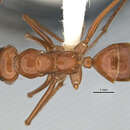pt-BR
nomes no trilho de navegação


Taxonomic history
Forel, 1886h PDF: 213 (s.); Forel, 1910b PDF: 60 (q.); Wheeler & Wheeler, 1953c PDF: 129 (l.).Status as species: Forel, 1886f: 213; Dalla Torre, 1893: 175; Forel, 1910b: 60; Forel, 1915b: 87; Emery, 1925b: 12; Taylor & Brown, 1985: 122; Bolton, 1995b: 250; Heterick et al., 2017 10.3897/zookeys.700.11784 PDF: 134 (redescription).Senior synonym of Melophorus cowlei: Clark, 1930c PDF: 22; Heterick et al., 2017 10.3897/zookeys.700.11784 PDF: 134.[[ worker ]] major. Long. 15 a 16 mill. Tete rectangulaire, large de 3 mill., longue de 2,6 mill. (sans les mandibules). Mandibules etroites, striees, munies de 4 a 5 dents irregulieres dont l'anterieure tres longue. Epistome court, subcarene, a bord anterieur subangulairement produit et cilie. Fossette clypeale grande. Ocelles petits. Yeux situes sur la face anterieure de la tete, vers son tiers posterieur. Thorax un peu echancre entre le pronotum et le mesonotum. Metathorax fortement etrangle. Ecaille assez epaisse, plane derriere, fort convexe devant, faiblement echancree a son bord superieur. Semi-luisant; tete finement reticulee, thorax finement reticule-ride et abdomen tres finement et densement ride en travers. Front finement ride longitudinalement. Pilosite presque nulle; quelques longs poils courbes barbiformes sous la tete. Pubescence nulle ou peu s'en faut. Quelques piquants courts et obliques sur les tibias. Sur les scapes et les cuisses une pubescence couchee plus abondante.
D'un jaune roussatre. Abdomen testace. Mandibules rougeatres a dents noiratres,
Australie, 21 degres de lat. sud (d'apres Lubbock).
L'abdomen de cette espece n'est pas seulement gonfle par une plenitude demesuree du jabot, mais ses lames segmentates sont extremement grandes. Le jabot se distend du reste beaucoup moins que chez le Myrmecocystus melliger , de sorte que cette fourmi ne me parait qu'un cas un peu plus tort des gonflements ordinaires.
Melophorus bagoti, or red honey ant, is an Australian species of desert ant in the subfamily Formicinae.[1]
Widespread in arid Central Australia, the species inhabits low-shrub and grassland deserts, where it builds fairly large underground nests.[2]
The outdoor activity is mainly restricted to the hotter summer months, when the ants are active during the heat of the day. Foragers usually begin their activity at soil surface temperatures of about 50 °C and continue to forage when soil temperatures are above 70 °C. They forage solitarily for food such as dead insects, seeds, and sugary plant exudates and are well known for their ability to store liquids in the abdomens of specialized workers, the so-called repletes or "honey pots", hence their common name "red honey ant" (the genus name Melophorus means "honey carrier").[2]
Nest relocation is possibly aided by trail laying behavior, which is highly unusual for solitary foraging desert ants. The founding stage of an ant colony is usually characterized by the same sequence of events. Reproduction occurs in synchronized mating flights, which are probably triggered by rain. The virgin queen leaves the nest in a mating flight and is inseminated by one or several males, and there is circumstantial evidence that males are chemically attracted to queens. She then looks for a new nest site and starts excavating a small nest, where she lays eggs and rears a small brood. The queens found new colonies independently and without the help of other queens or workers; this mode of colony founding is common in formicine ants. However, nothing is known about the number of queens in later colony stages or other populations of M. bagoti.[2]
Melophorus bagoti, or red honey ant, is an Australian species of desert ant in the subfamily Formicinae.
Melophorus bagoti is een mierensoort uit de onderfamilie van de schubmieren (Formicinae).[1][2] De wetenschappelijke naam van de soort is voor het eerst geldig gepubliceerd in 1883 door Lubbock.
Bronnen, noten en/of referenties